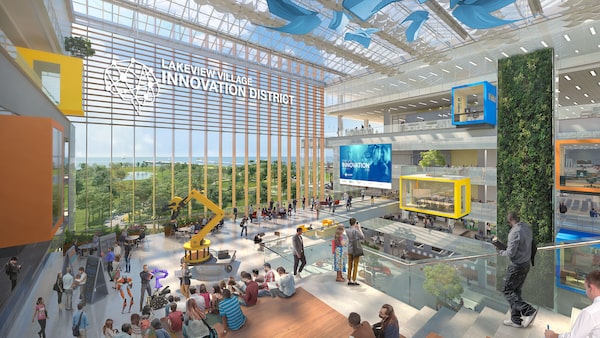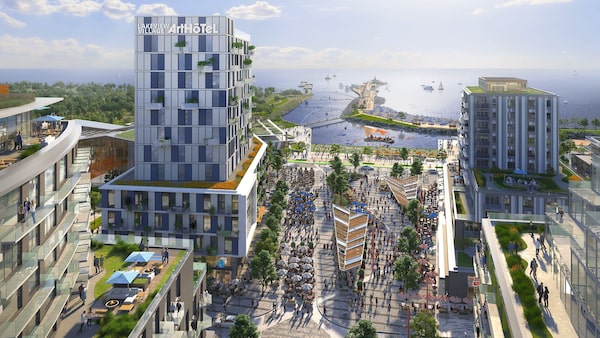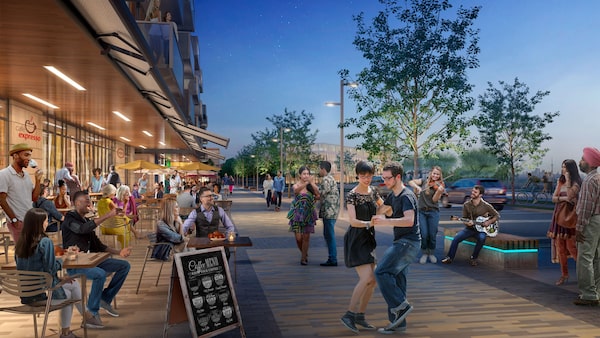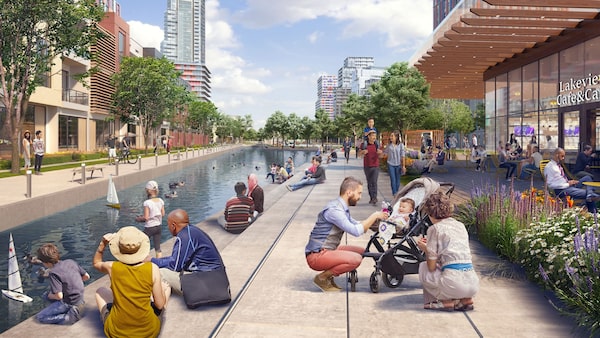
Lakeview Village will be built at the site of Ontario Power Generation’s Lakeview Generating Station.CICADA DESIGN
A controversial site on the shores of Lake Ontario, once the location of a coal-fired power plant, is being transformed into an environmental showcase, with waterfront destination, with a commercial and residential development and conservation area.
Lakeview Village will be built on 177 acres (71.6 hectares) at the site of Ontario Power Generation’s Lakeview Generating Station. The project’s consortium, a group of developers, architects and designers called Lakeview Community Partners Ltd., aims to transform the site where acrid fumes once spread acid rain and greenhouse gases into a mixed-use commercial, residential and green space area that makes Lake Ontario accessible to the public.
The power plant was demolished by Ontario’s previous Liberal government as part of the province’s move toward lower carbon emissions. It was blown up in 2006 in a controlled explosion.
We aim to transform it completely into something that is incongruent with its coal-burning days, when the waterfront was cut off from the community.
— Brian Sutherland, vice-president of development at Argo Development Corporation
The plant’s demise triggered controversy when the Ontario government planned to replace its power generation with a gas-fired plant to be constructed in Mississauga. After intense opposition, the government cancelled the Mississauga gas plant, along with a proposed plant in Oakville, just days before a provincial election, angering political opponents.
The new site will be environment-friendly, says Brian Sutherland, vice-president of development at Argo Development Corporation and lead for the consortium.
“It’s going to be a destination waterfront,” he says. “Our starting point is to take the foundations of a polluting power plant and turn it into the foundations for a green, coastal conservation area.”
Lakeview Village will include more than 8,000 homes, which will house up to 20,000 people, as well as 1.8 million square feet of office space and 200,000 square feet of retail space, with an estimated 9,000 people working in the area when it’s done.
The developers aim to promote the office space as an “innovation centre” attracting tech and design workers. The builders also hope to partner with a university or community college.
The area will also incorporate the old power plant’s pier, which was used for unloading coal, as a promenade jutting out 600 metres into Lake Ontario. The pier is the longest on the Canadian side of the Great Lakes.


The project’s consortium, a group of developers, architects and designers called Lakeview Community Partners Ltd., aims to transform the site from a brownfield into a burgeoning community hub.CICADA DESIGN
“It will be completely accessible to the public and it will be a really special place to go. When you walk out there you get the feeling and the view that you’d get [if you were on] a boat,” Mr. Sutherland says.
The pier is only part of the plan to make the area and the lakefront more environmentally and pedestrian friendly. Ever since 2018, when the consortium was given the go-ahead by the City of Mississauga to develop the site, the builders group has been trying to veer the property away from its 20th-century legacy as a power plant polluter, Mr. Sutherland adds.
“We aim to transform it completely into something that is incongruent with its coal-burning days, when the waterfront was cut off from the community,” he explains.
To help achieve this, the consortium has donated the rubble from the power plant and the extensive tunnel work that was underneath it to the Credit Valley Conservation Authority, which has been building a 64-acre waterfront park along the edge of the lake.
Lakeview’s consortium donated more than 200,000 tonnes of rubble and 5,000 tonnes of rebar to help fill and build the foundation and breakwater for the Jim Tovey Lakeview Conservation Area, named after a Mississauga councillor who championed an accessible lakefront. When it’s finished, the park, with wetlands and naturalized habitat, will also add 3.5 kilometres to Lake Ontario’s waterfront trail, connecting Mississauga with cycling and walking trails in Toronto.
“Donating all this concrete and rubble allowed them to speed up establishing the site and reconnecting the waterfront to the city,” Mr. Sutherland says. The concrete had to be tested to make sure it wasn’t polluted, he adds.
Having a consortium collaborating with the city to develop such a large site makes it easier to realize the overall vision of a village with places to live, work, shop and play, says Rob Spanier, president of Spanier Group and development adviser for Lakeview Community Partners Limited.
“More often with a site this size, you have a bunch of different owners with different ideas. Here we can work in lockstep with the city,” Mr. Spanier says.
The partnership submitted its overall master plan to Mississauga in 2018, the year when Ontario Power Generation sold the site; the city gave development approval in November, 2021.
Plans are to have the site serviced this coming summer, with construction to begin in the fall and people able to move in starting in 2025. The partners want to make sure it’s an environmental showcase.


The consortium has donated the rubble from the power plant and the extensive tunnel work that was underneath it to the Credit Valley Conservation Authority.CICADA DESIGN
“If we can make these places platforms for learning, Lakeview can be a case study for how these sustainable communities can be achieved,” Mr. Spanier says.
The consortium is looking also to supplant the site’s legacy as a coal-chugging plant with technologies such as district heating and cooling using lake water, which downtown Toronto has, and a central vacuuming system for collecting garbage. The Lakeview group sent a team to Sweden to look at the central garbage system there, he explains.
Eventually, he hopes developers from other countries come to see what Lakeview has done.
The developers also want the retail mix in the area to include local businesses as well as big national and international chains. The idea is to have a community with easy access to the lake and parks as well as to city life, both in the neighbourhood and beyond.
“There needs to be more than a bedroom community with condos,” Mr. Spanier says. “It needs to be a true mixed-use, 15-minute city, where you’re 15 minutes from everything, even if you walk or cycle to get there.”
Your house is your most valuable asset. We have a weekly Real Estate newsletter to help you stay on top of news on the housing market, mortgages, the latest closings and more. Sign up today.